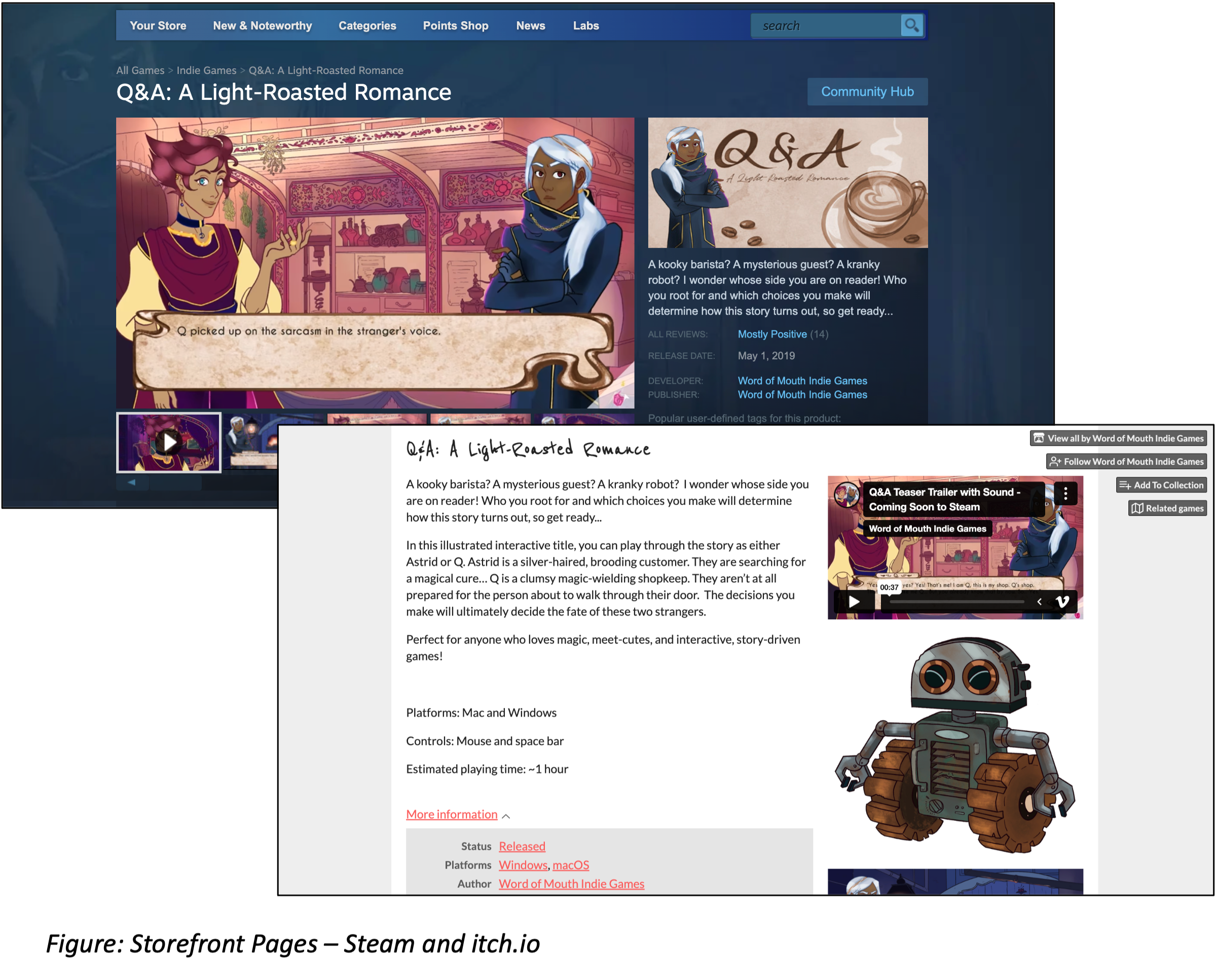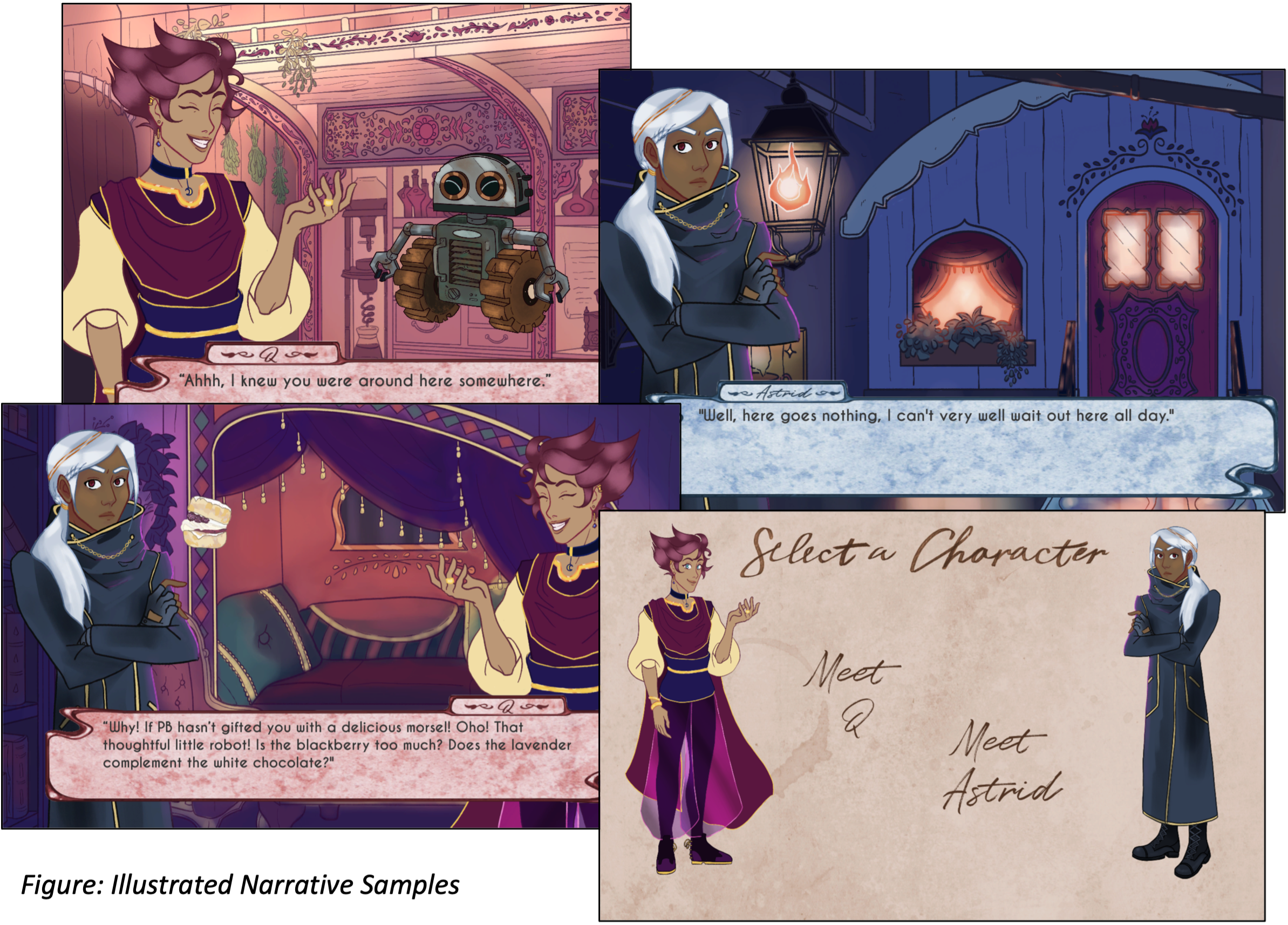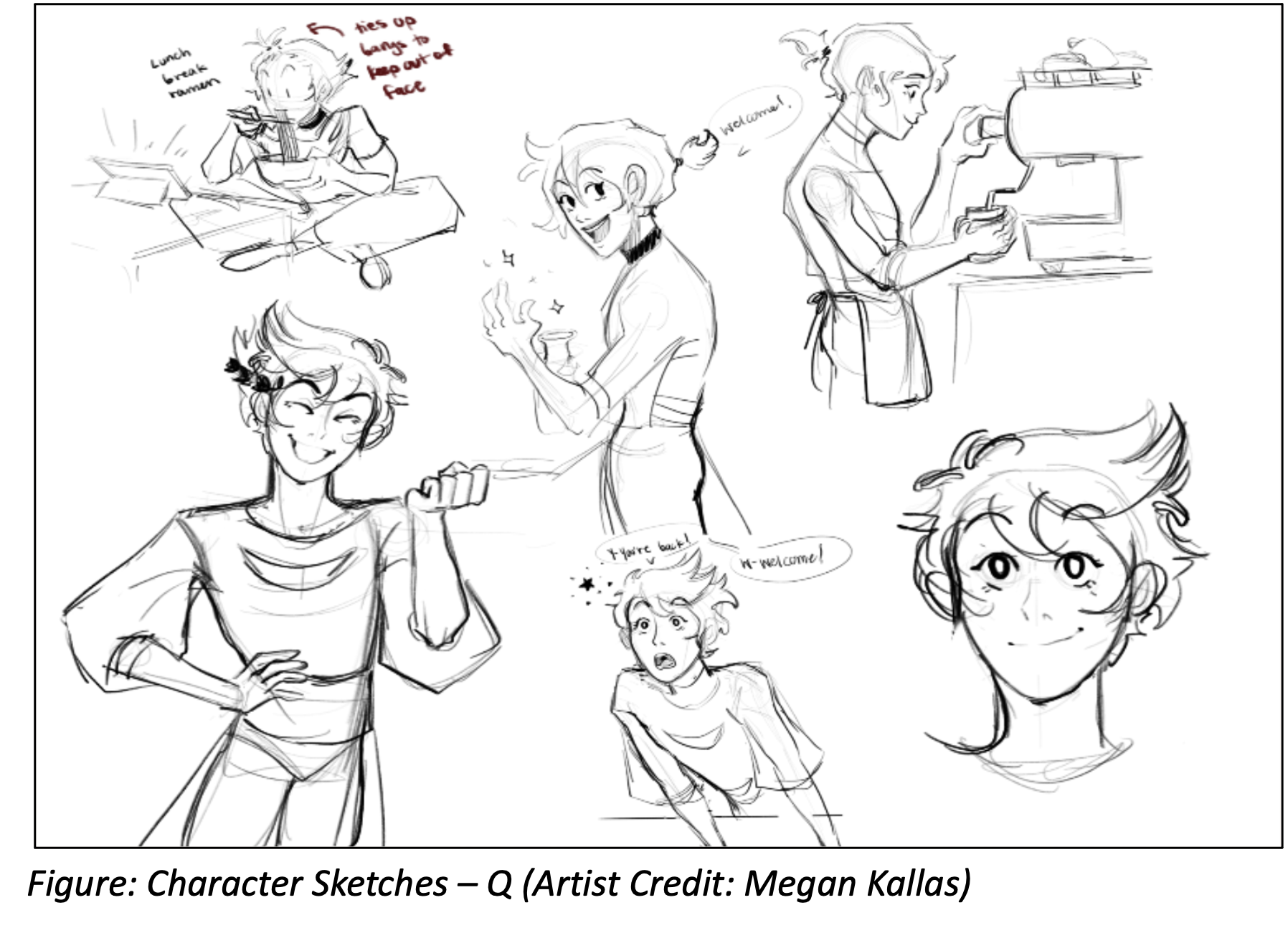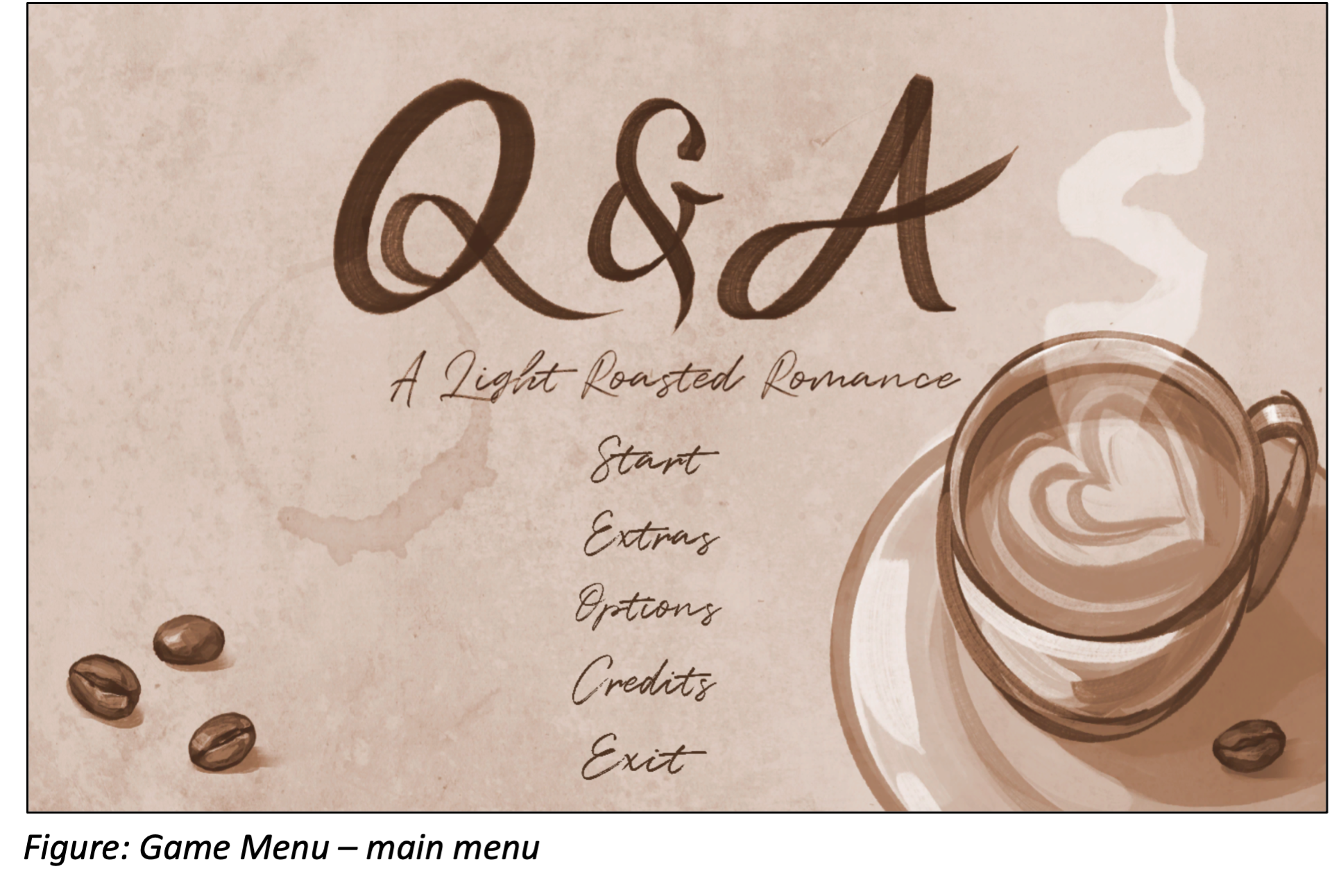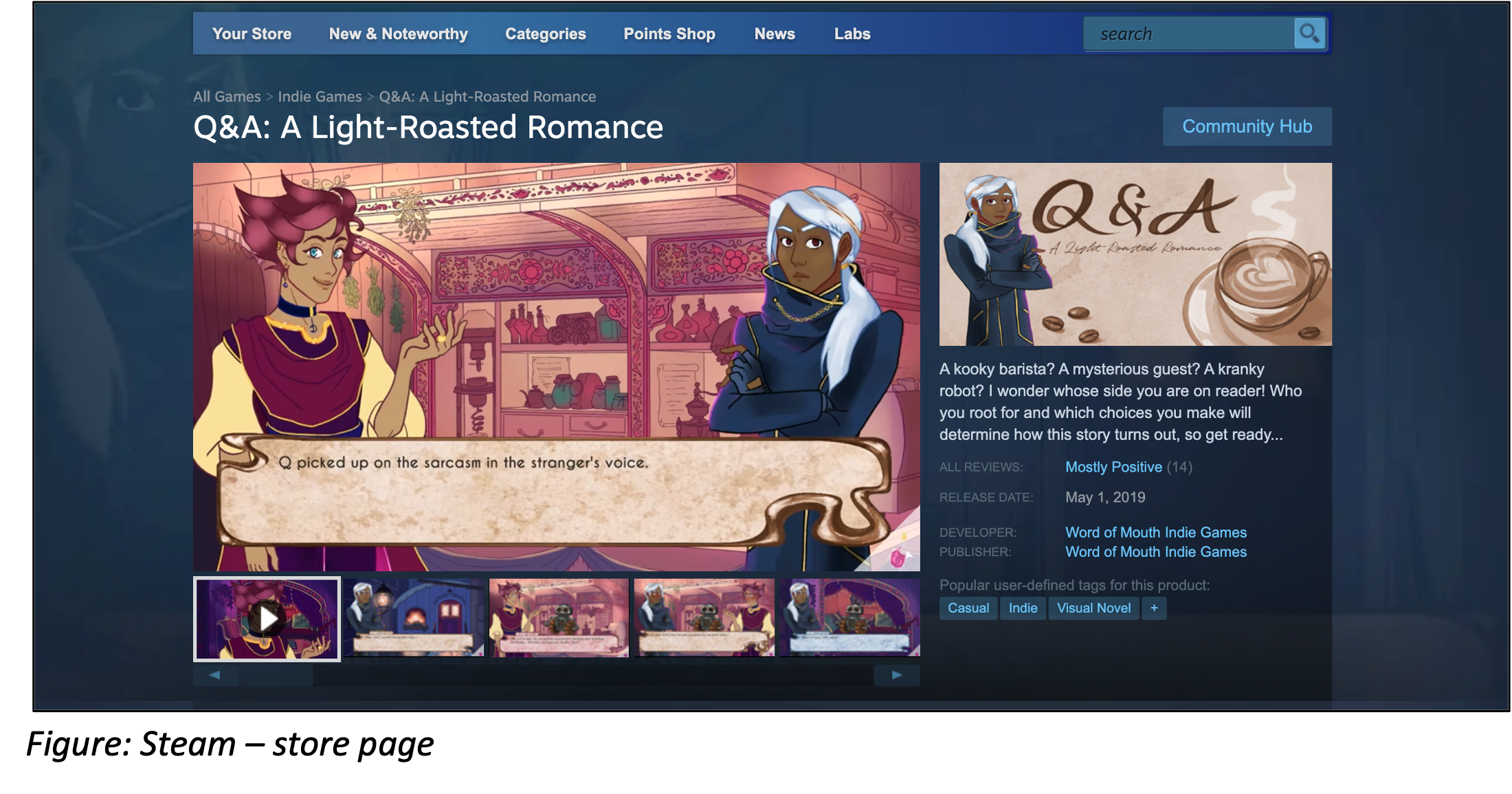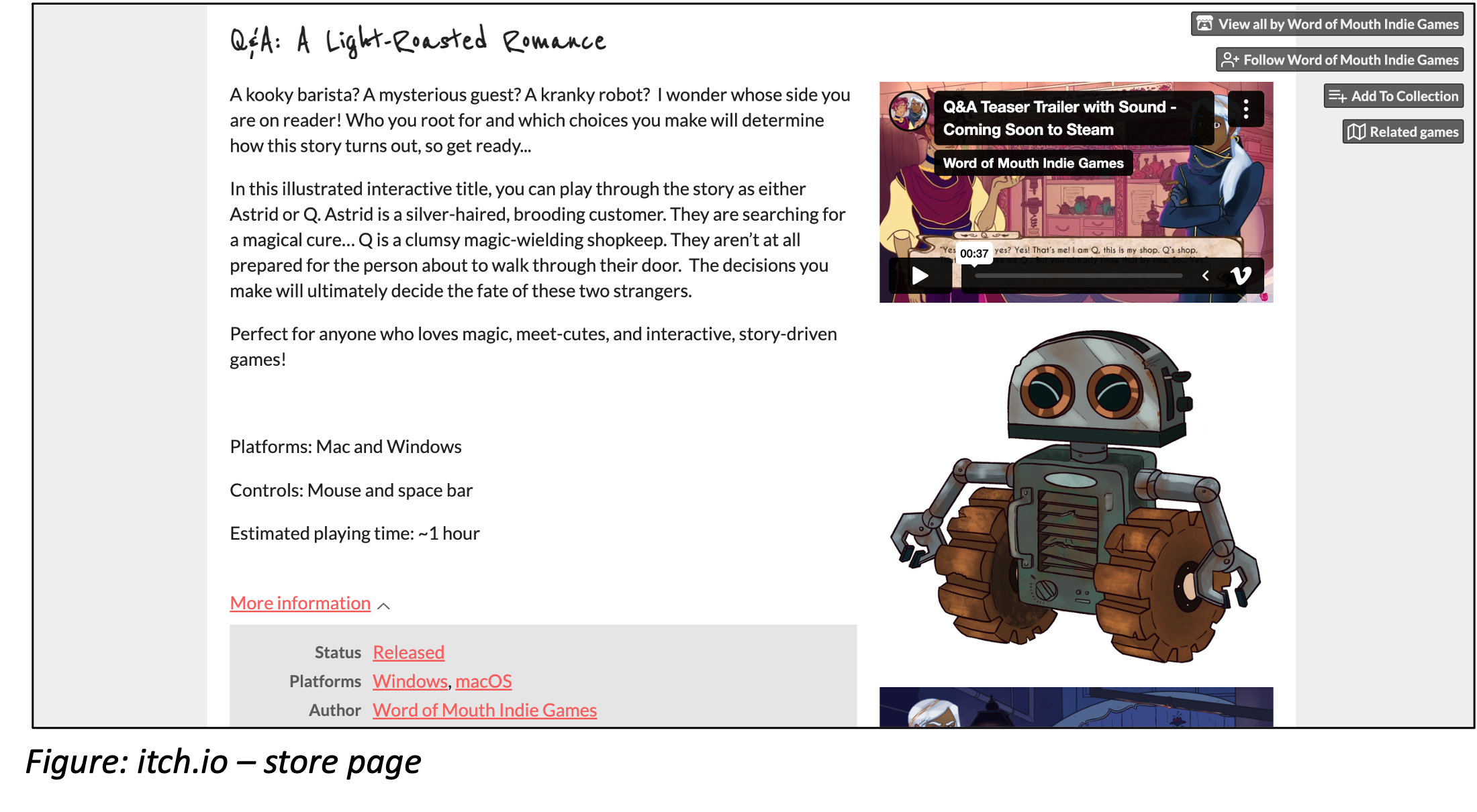Game Design:
Q&A: A Light-Roasted Romance
Game Design Overview
The Product
Q&A: A LIGHT-ROASTED ROMANCE is a 2D visual narrative game about two different characters meeting in a magical coffee shop in a story-driven, interactive experience. The characters Q (the clumsy shopkeeper), Astrid (the brooding customer), and PB (the lovable robot) welcome the player into their world and let them be a part of their story. The player in this game chooses whether they will play as Q or Astrid, clicks through the rich visuals, decides on different narrative options, and sees how their decisions impact their playthrough and the beginnings of a light-hearted romance.
The trailer for this visual novel/narrative title is shared below.
Q&A: A LIGHT-ROASTED ROMANCE launched in February 2019, and its store pages and playable downloads can be found below:
Platform & Engine
This game was developed for PC using the Unity Game Engine. It was distributed on two different PC game stores for free: the Steam store and the independent game store platform itch.io.
Project Duration & Team Composition
This project spanned 2-3 months of development with a small three-person core team, along with me acting as a key consultant around programming, design, production, and editorial. The core team was composed of a lead designer/art director and two artists who worked on ideation, concept, and final art.
This game title was launched in February 2019 on the itch.io storefront and in March 2019 on the Steam storefront.
The Goal
The goal of Q&A was to provide a visually and narratively rich game experience that was cute, clean, and romantic with a good dose of humor. It was crafted with the additional mission of welcoming a diverse audience and of showcasing the art and direction behind the project.
Role & Responsibilities
Consulting Producer, Designer/Programmer, and Editor
My role in this project was that of a consultant with key contributions around a wide variety of areas:
production
design
ideation
programming
narrative
editorial
As the programming specialist on hand and having led a project prior to this with two of the core members, I helped scaffold milestones and provide recommendations around early development and design decisions. One key element I helped with here was providing guidance around programming in C# in a way that could support a narrative branching game within the Unity game engine.
As an editor, I also gave advice and structure around the development of the two-sided narrative that was featured in Q&A: A LIGHT-ROASTED ROMANCE. Toward the end of development, I worked on editing and cutting down the text so that the game was a more fluid and streamlined experience for players/users. This had a large impact on the user experience regarding text on the screen.
The final aspect I helped with was playtesting, troubleshooting bugs, and polish as the game approached launch and distribution for the Windows and Mac platforms.
Game Design Snapshot:
Understanding the Audience
Who is the game for? What prior experience do they bring, if any? Within game design, the player is the one who will interact with the final product. Understanding that the audience is key to making a game that provides a valuable player experience and satisfies player needs.
The Player: Overview
Q&A: A LIGHT-ROASTED ROMANCE is a narrative title for players looking for a fresh, original story about two strangers meeting for the first time in a potential romantic meet-cute. It was created for a diverse audience who were interested in strong characters, fantasy, humor, and games where player decisions impact the story. Additionally, the controls and mechanics were designed to be simple and intuitive to pick up so that the game was accessible to a wide audience.
The Player: Pain Points
Pain Point: Two-dimensional, disjointed, or unsatisfying narrative worlds
Summary: When players are looking for a story or narrative, in any format, it is a major pain point if that story doesn’t deliver on the promise that they expected. If the characters fall flat, the story doesn’t make sense, or it simply isn’t satisfying to learn about, the story has caused friction with its audience.
Goal: Provide an immersive world and compelling story for players that they can interact with and feel happy spending time with.
Pain Point: Frustrated by barriers to entry with games, controls, or mechanics
Summary: Even if players want to engage with a game or interactive experience, they can be easily annoyed or frustrated if there are any obstacles that make it difficult to do so. They want to be able to play the game—but can be overwhelmed or disappointed if they need to navigate confusing menus, learn a lot of controls, or have to master mechanics that they are unfamiliar with.
Goal: Give players an intuitive and easily accessible on-ramp to playing a game they found interesting.
Pain Point: Not wanting to invest in a heavy, complex, or dramatic story
Summary: There are so many narratives and stories in the video game landscape, and some players will be looking for fun titles that are entertaining yet thoughtful. Narrative games/narrative experiences that take themselves too seriously or become a slog for one reason or another can be a major pain point for users looking for a game that is low-pressure and fun.
Goal: Provide a game that is light, engaging, and thought-provoking with potential replay value.
Goals & Limitations
The goals and limitations around this project were simple and straightforward. Within the limits of the project—a small team and a short timeline—we wanted to address player pain points and provide a unique and fresh game experience that featured an impactful narrative.
Restrictions & Limitations
The first major limitation for this small team was keeping the development timeline to only a couple of months. Second, since there wasn’t a specific programming expert or computer, the coding and game engine work had to be done in a strategic yet scalable way with minimal input from the programming consultant (myself). Third, the game needed to strongly leverage story and art as the key pillars, as those were the specialties in which the main team was strongest.
Features & Value Propositions
Light, fun, and immersive story with a hint of romance
Choice of playing one of two different POVs (Q or Astrid)
Player actions allowing for impact on the story/outcomes
Magical and fantastical world that is easy to engage with
Complex but approachable characters
Cohesive art and story that brought out the best in each other
Bespoke art, assets, and scripting
Replayability
Game Design Process
Q&A: A LIGHT-ROASTED ROMANCE was created with the idea to make a short, interactive narrative game for a diverse audience. It began with planning, brainstorming, and ideation meetings between the core three-person team in charge of the project.
The story (written from two different characters’ perspectives) was a key component that was written by the lead on the project and was then used as the base for the rest of the design process. The art, following story development, went through sketches, concept, and final art for both characters and background.
The process overview below covers the development for this title in more detail.
Player Experience & UX Considerations
The player experience/user experience for this game revolved around a seamless, story-driven, and interactive experience. Could the team create an accessible title that emphasized player choice in an interesting way? Did the story and art mesh in a satisfying way that drew in the player? A final consideration was whether the interactive platform of a 2D game was leveraged in a way that made sense to the player as well.
From the menu to the narrative text and dialogue, the goal for the overall player experience was to have a short but satisfying game experience that led to funny, feel-good, and heartfelt moments. We also wanted there to be a noticeable difference in playing the two different main character perspectives.
By going over the delivery of the story in text and art multiple times, the team was able to focus on creating a streamlined player experience over the two-month development period.
Story/Narrative
The story for Q&A: A LIGHT-ROASTED ROMANCE centers around one of two non-binary perspectives: Astrid, a broody stranger looking for a cure to a stony heart, and Q, an eccentric and quirky purveyor of magical potions. There is also a fun sidekick/mascot character to add levity and outside action to this story through Q's little friend, PB, the mechanical robot. These characters live in a magical/steampunk-type world, even though the story doesn’t dive too deep into this at the surface level.
The premise for the game and story started around these characters and settings and evolved from there.
The narrative is summarized below:
Astrid is someone looking for a rare cure to a mysterious illness around a stony heart and finds their way to a small magical coffee/potions shop run by Q, an eccentric master of magic and potions, with the help of their trusty little mechanical robot, PB. As Astrid and Q interact, they get to know each other, and Q is able to provide Astrid with a magical potion that should help with their condition of the heart. There are moments of mishaps, misunderstanding, feeling, embarrassment, and vulnerability throughout their time together. Astrid gets the potion from Q and spends some time in their shop throughout the story. As evening comes on, Astrid leaves Q’s shop but not before they both recognize that there might be a true connection there.
Game Art – Concept to Final
This narrative title relied heavily on the art and illustrations to make it truly come to life. The process for developing this art followed a traditional design/illustration route. It started with general artistic direction and references, followed by early sketches and iterations that were talked over by the team. The core team decided on final art choices and refined those as the rest of the game was being developed with placeholder art or sketches in the meantime.
Art for this game was split into character art and background art, which have been highlighted below with samples:
Character Art
Background Art
Sound Design
For this project, there wasn’t a dedicated sound designer or audio specialist, but the lead on the project integrated audio for all the key elements in a cohesive way and developed these along with the rest of the game assets. These sound design components included button clicks, sound effects, and a looping background soundtrack for the game.
UI/Menu Design
The UI for this game title was kept simple and clean to get players into the player experience as soon as possible. It featured bespoke menu art, included only a few menu options (start, credits, quit, sound, options), and was intuitive to navigate.
Testing/User Feedback
The development team conducted internal usability tests to help with the iteration process and collected player feedback after the title shipped. Future projects would ideally have time and resources to allow for more robust playtesting and research.
Internal Usability Testing
Internal playtests of the title took place throughout development and highlighted three key aspects to consider for the final product.
Testing Note #1:
First, we had to be careful of having too much text on the screen at any point. The narrative text of the story itself—from the dialogue to exposition to narrative choices—needed to be edited and cut down to best fit the UI. When the text was too long or crowded the screen, it negatively impacted the player's experience.
Testing Note #2:
Second, both the text timing and ability to skip text were tricky to nail down. The team didn’t want players to accidentally miss key parts of the narrative, but didn’t want the players to be stuck behind text they had already read. Internal playtests helped dial in the text delay, text speed, and how much time was needed on each screen.
Testing Note #3:
Third, it was important to add variety, excitement, humor, and intrigue to the interactive experience. However, the game had a lot of static elements, such as two characters speaking in the same place for a while, and these moments needed to be exciting as well. Internal playtests helped get a sense for pacing and when things such as sound effects and simple animations could be added with the resources at hand to create more dynamic scenes and settings.
Player Feedback (Post-Launch)
After the official launch of Q&A: A LIGHT-ROASTED ROMANCE on the Steam platform, players were able to leave ratings and reviews that could be reviewed later. It had a “mostly positive” review rank, which was deemed an achievement for a small project developed by only 3-4 people over a couple of months. One specific highlight from the player feedback was that the robot PB was a crowd favorite (matching how the team felt as well, which was satisfying to learn).
The team was also able to gather feedback about pain points that could be addressed with any further development:
Text speed/ability to skip text
Players who wanted to play the game faster were sometimes frustrated by not being able to skip through text as fast as they naturally wanted to. To tackle this problem would most likely take further study, but the feedback highlighted a challenging aspect of narrative games/visual novels.
Save files
Some players wanted to break up their playthrough into multiple sessions or explore all the narrative possibilities without doing a full playthrough each time. They expressed that they wanted the option to save files—which wasn’t within the scope of the project but made sense to include or add at a later point.
Background music/soundtrack
One or two players commented on the fact that the looped soundtrack felt too monotonous, which was great feedback. In any further development, multiple background musical themes could be included to highlight different scenes or moments in the story. The main menu could have a unique soundtrack as well.
While we received player feedback on more pain points after development was complete, it was helpful for the retrospective and takeaways section of this project.
Shipped Product
Q&A: A LIGHT-ROASTED ROMANCE shipped as a final product in February-March 2019. This independent game is a complete digital product that was distributed first on the itch.io online storefront and later on the Steam platform. It was free to any PC user and was made available on both Mac and PC, accommodating standard screen resolutions. With a small team of three plus a consultant, this project was seen as a success.
Some key wins included the following: the story was integrated well into the gameplay experience, the characters were memorable and thought-provoking, and there was a substantial difference between playing the two different perspectives of Q and Astrid. These wins and other details around the shipped product are outlined below.
UX/Player Experience Highlights
Characters & Setting
Q&A: A LIGHT-ROASTED ROMANCE centered around a strong set of characters and settings. Astrid, Q, and PB the robot were all fleshed out in writing and through art, which was a key value proposition for the title. Each character was distinct and memorable, and the cast of characters produced satisfying scenarios and interactions from start to end.
The setting was important as well but needed to be woven subtly into the background of the story. This was communicated largely by the art and by small details about each character that came up. In this way, the player could tell that they were in a magical yet grounded world through Q’s potions and magic powers. They could also pick up elements of a mechanical or steampunk twist through PB, the scrap-built robot, and Astrid’s background as a mechanic.
Additionally, while the setting was a magical coffee shop, there were several set pieces that were used surrounding this space to give the characters different places in which to interact. This helped provide a sense of depth with the strategic use of a few high-quality art assets.
Player Choice & Narrative Interaction
The story of Astrid and Q was always imagined as a small-scale meet-cute that the development team could explore and expand upon in depth. The gameplay centered around a key narrative decision before the player even started the true game: to pick a character. A short and simple bio was provided for both Astrid and Q, and then the player interacted with the story from one of those two main characters’ perspectives through the entire playthrough.
The final product clearly delineated who was speaking and when the player had to make a choice about what to say or do. Visually, the player could tell who was speaking based on both the color and position of the different dialogue boxes and player choice windows that appeared throughout the story.
This narrative journey and set of player interactions achieved the team’s major goals surrounding the player’s story experience.
Animations, Visual Effects, Sound Effects
Additional elements that helped give the game an immersive and dynamic feel were small details around screen and character animations, simple visual effects, and well-timed sound effects. Characters sliding on and off screen, a sound of clattering objects, and screen transitions all helped build a holistic user experience.
UI, Menus, Microcopy, Narrative Text
In this project, there was a fair amount of UX writing and UI design that had to be considered across the different screens that were featured in the game. The menus were clean and simple. They let players start the game, change audio options, see extras (game art and concept sketches), roll the credits, and quit the game. A pause menu was kept simple as well, with options to access the main menu, change audio settings, resume the game, or quit. At the top level, this microcopy was kept as simple as possible with the use of only one or two words at a time.
Narrative text was a big asset woven throughout the game. It was placed strategically within thematically colored boxes on the screen, depending on who was speaking or if there was a choice for the player to make. This text was refined over time to fit a specific word count that enhanced the narrative and overall user experience. There was also a thematically aligned button in the shape of a potion used next to text or story moments to allow the player to click through the game.
Team Credits
The team of independent game developers, operating under the moniker of Word of Mouth Indie Games/Wrenbird Productions, is credited in full within the product by name/role through a traditional rolling credits sequence.
Distribution
The game itself was packaged and delivered to PC players for free on two different platforms: indie game storefront itch.io and the more mainstream Steam game store. The store page in both cases featured a trailer, screenshots, promotional/marketing copy, and instructions for how to play the game.
Learnings & Takeaways
This project was a challenging but satisfying experience for the development team. From start to finish, Q&A: A LIGHT-ROASTED ROMANCE was an ambitious project considering the limited time and resources at hand. The team was happy to be able to deliver a unique, compelling, and cohesive product. It provided a fully illustrated narrative experience that players could interact with in meaningful ways, featured characters that were relatable, and spoke to a diverse audience.
In retrospect, there were several key wins and product pain points that the team learned from and that could provide value to any future products we might work on.
Product Wins
The narrative title Q&A: A LIGHT-ROASTED ROMANCE delivered several key wins around story and gameplay. The original story and characters were brought to life effectively in both text and art. Emotion and humor were communicated well, and the world itself had depth to it that was seen in the little details, both written and illustrated.
The game mechanics around this story were delivered simply and intuitively, with each playthrough feeling distinct and whole. This value proposition was especially obvious when users played through both of the main characters’ perspectives—perspectives which told the same story while feeling different in terms of voice, stakes, and player decision-making.
Notably, the final product felt polished and completed to a high standard. Because the narrative scope of the project was restricted to a meet-cute with romantic potential at a magical coffee shop, the team could deliver a quality end product with polished art and narrative mechanics. The team was also able to invest in additional game production and development around menus, editorial work, quality assurance testing, sound, and animation.
Product Pain Points
As noted above, player feedback after launch did highlight pain points that are worth mentioning and would be considered during any further development.
Product Pain Point #1:
Players specifically called out text speed as something that sometimes felt too slow when they wanted it to go faster or when they wanted to skip through dialogue at a faster speed. Making sure that players can go as fast as they want while not missing key information is a challenging aspect of narrative games and would continue to be honed if any further work were done.
Product Pain Point #2:
A request to have save files was also mentioned by some players, which would make sense with more resources and time. One of the reasons the game was kept fairly short was to avoid save files being a barrier to entry, as this was a technical feature that was outside of the scope of this project. However, if save files were available, then players would be able to stop freely without losing progress and could also explore the different branches of the narrative more freely.
Product Pain Point #3:
Both sound design and animation were potential pain points as neither was a focus of this project and there were not many resources to support these. Enhanced sound design, with different musical tracks/themes and sound effects, would help alleviate a lack of variety in terms of audio and music. Animations likewise have room for improvement to create more dynamic beats within the game and story.
Product Pain Point #4:
A final pain point is one not mentioned by players but is a consideration as designers: accessibility. Given enough time, resources, or personnel, accessibility could be expanded to include subtitles, additional language support besides English, and color options such as a high-contrast mode. These are just a few accessibility considerations that would allow for more players to interact with the game with ease.
Future Design Work
When I look ahead to future game development projects or digital products, Q&A: A LIGHT-ROASTED ROMANCE provides several key takeaways.
User testing and iteration
Because this game was distributed freely on the largest mainstream PC game store, Steam, the team could observe a lot of user feedback compared to if the game were only listed on the independent store of itch.io. This user feedback showcased how useful further rounds of user testing and iteration would have made the final product stronger and how important it is to include in future game design/UX considerations.
User save files and user pace
Save files and the ability for users to go at their own pace can make a big difference to the user experience. Saved data is a key aspect of many digital products, and it allows users to input data or revisit information less often. Additionally, it is more common for users to want to interact with products at their own pace and that control empowers users.
Accessibility considerations
Expanding access and lowering barriers to entry will continue to be a consideration in any future design projects. With the appropriate technology and resources, we can help ensure that we build out inclusive and equitable designs. From subtitles to color contrast to alternate user input options, there are many ways to help provide an accessible experience.
In closing, this visually driven narrative game was a fun, engaging, and successful product that challenged the development team and helped showcase ways to build even better products and user experiences in the future. Looking back, we can all be proud of the work we did and look forward to how we can apply this design experience to whatever comes next.



